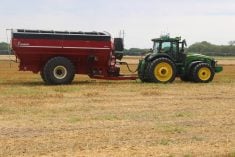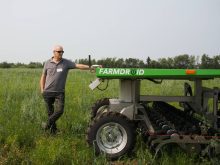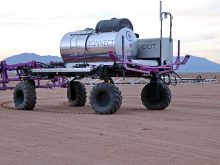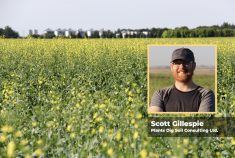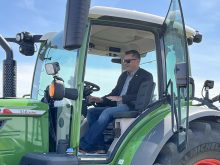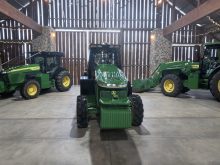John Burns established Windy Poplars Farms at Wynyard, Sask., in 1975. Burns has always incorporated new technologies as the farm grew to 22,000 acres. His latest new tool? Raven’s Omnipower.
Burns said the machine functioned as expected, but the autonomous drive system is defunct without GPS guidance.
Related story in this issue: Olds puts Omnipower to the test
“Have there been glitches? Yes. We don’t have a strong enough internet service in Western Canada,” said Burns, adding they used it this year for fertilizer applications and for seeding plots.
Read Also

Short rapeseed crop may put China in a bind
Industry thinks China’s rapeseed crop is way smaller than the official government estimate. The country’s canola imports will also be down, so there will be a lot of unmet demand.
“Typically, it will only seed about 2,000 acres per year for us, plus put down another 8,000 or 9,000 acres fertilizer. It’s not intended to be a high performance machine. We probably put on more acres than anyone else in the world.”
He said last fall they seeded winter wheat with a regular drill and with Omnipower.
“The Omnipower had better seed singulation than any of our other drills. It’s gravity fed seed so it should get more uniform seed distribution. The more you depend on gravity and less on air volume, the more precise you are with placement.”
He said farmers serious about variable rate and other precision farming technology will have advantages in using a smaller unit.
“Of course, the Omnipower is single rank, so there are challenges in clearing residue.”
He said his prototype and other Omnipower units in farmers’ hands, are only research and development units. Still, they suffer from a lack of power.
“When we have a downpour, the regular tractor drills can usually go. The Omnipower has to wait until things dry up a little. It doesn’t have enough power and traction. So we put it in areas where it will work. Could we use it everywhere? No, not at this point.
“Compared to a tractor and a drill, the conventional seeding setup covers more ground, but the Omnipower does it more efficiently and with more precision. It’s quality versus quantity.”
He said the era of autonomous implements has not yet arrived. He compares them to electric vehicles, whose time has just come too soon. He said there’s little support for robotic vehicles in government regulations or within the industry for completely autonomous vehicles.
“From what we’ve learned in talking to Raven people, this is an experiment to see how they can adapt the technology to other lines of equipment.”
A goal Raven had for Omnipower is to analyze the technology of multiple farm implements talking to one another in the field, optimizing their performance. That includes seeders, sprayers, combines grain carts and lunch quads.
This was achieved on the Windy Poplars Farm last fall when an operator in the drill tractor also controlled their Omnipower unit, said Burns.
“The drill operator simultaneously controlled his drill and the Omnipower in the field. And they could easily talk to each other.
“This technology is applicable to any location in the world with broad acres, but it’s especially relevant to Saskatchewan and western Canada. We’re most able to accommodate new technology because of our level of education. It’s pretty remarkable.”




